Rybow
Well-known member
I know that most of the projects here focus on pro audio recording/mixing/mastering gear, but I just finished a chip amp, and I would like to share it with you guys! After building it, I am seriously considering building another to power some passive monitors in my little studio.
It all started when my Dad sent me an email asking me to look at some little Pyle amp. He wanted an amp to power some small 6Ω bookshelf speakers in his home office for music listening, and he wanted the price tag to be under $100. I looked at the amp in question, sent my Dad a reply that it would be less than awesome, and jumped head first into building him one for the price tag of $100. Of course, it ended up costing 4 times that to build, so Merry Christmas, Happy Birthday, and Happy Father's day Dad. I just gave the amp to my Dad a week ago. It spent one day powering the bookshelf speakers before being moved upstairs and connected to his Kef Hi fi's. I think I went overboard.
LM3886 chip amp stereo kit from chip amp.com, Rod Elliotts P88 OPA2134 pre amp, 225VA Hammond 22V toroid, ALPS blue velvet pot and a 12"x8"x3" Hammond aluminum chassis. The sound is soooooooo good! Optimized to deliver 60+ watts into 6Ω, 40 Watts into 8Ω. Tested on my Kef C40's, 100 watt towers, showed that 40 watts from a chip amp is a silly amount of power. No hum, no buzz, no electrocution, no speaker short protection, no slow start and no mute circuitry. Kept it simple to increase chance of success. The power light is a blue LED mounted on the PS board. It can be seen through the vents. I wanted to keep the look clean and classy.
Enough talk. Picture time!
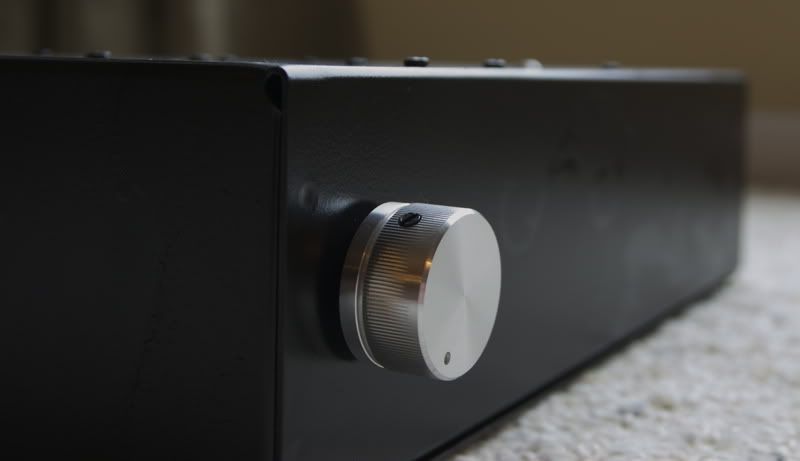
Front graphics
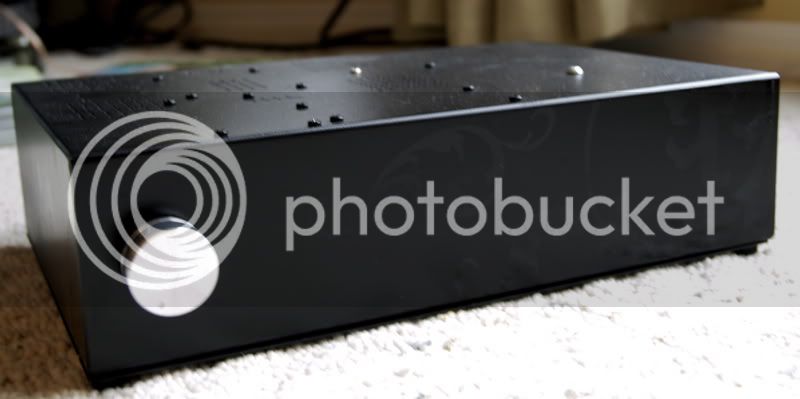
Back connections. Slight Dremel slip on the IEC. Whoops!
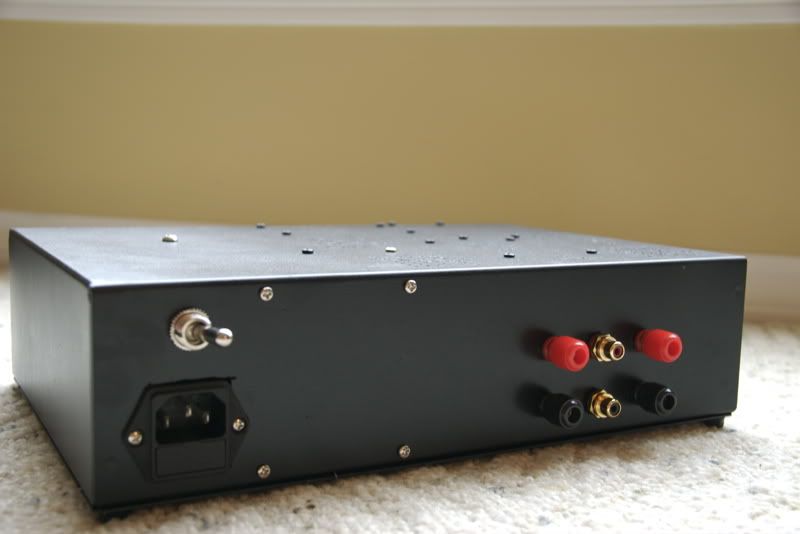
A little too ambitious on the top vent. I don't have a drill press, so just a hand held power drill. Despite centre punching, the drill slid around a bit. You can see where I start and then get better at it
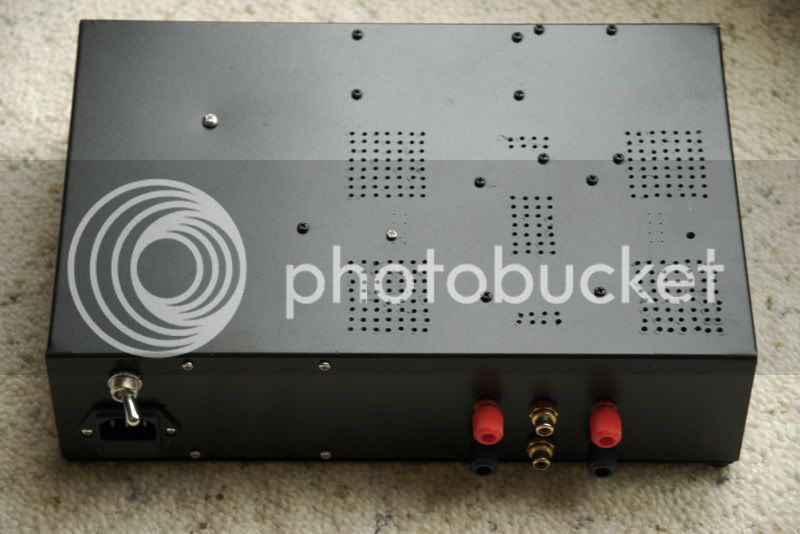
Here is what I should have done on the top
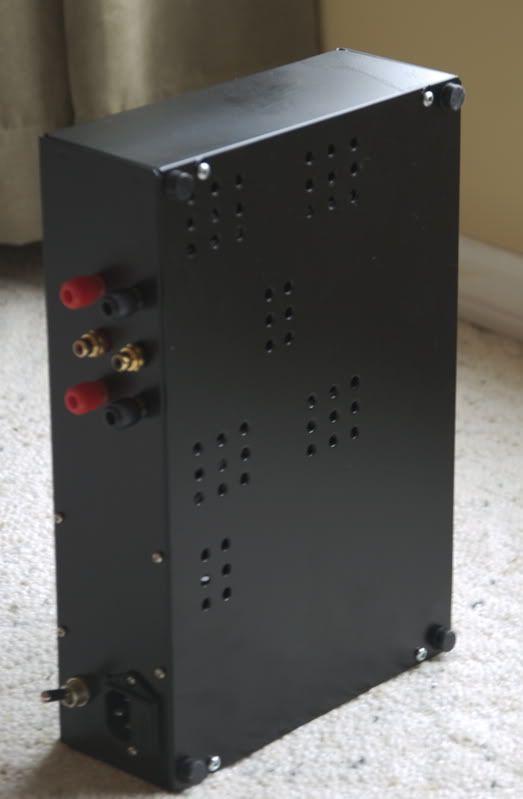
The guts pre-paint. You can see it's a tight fit. Despite the close proximity, there is no hum from AC leakage.
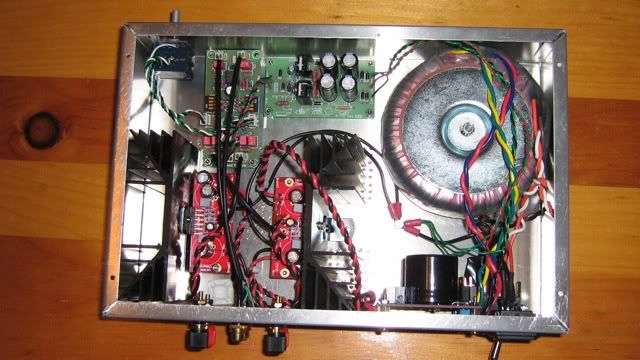
I tried to think of ways to tell my Dad that I couldn't do it so I could keep it for myself, and then buy him a $100 amp. He was like a kid on christmas day when he pulled it out of the box, so it was more than worth it in the end.
It all started when my Dad sent me an email asking me to look at some little Pyle amp. He wanted an amp to power some small 6Ω bookshelf speakers in his home office for music listening, and he wanted the price tag to be under $100. I looked at the amp in question, sent my Dad a reply that it would be less than awesome, and jumped head first into building him one for the price tag of $100. Of course, it ended up costing 4 times that to build, so Merry Christmas, Happy Birthday, and Happy Father's day Dad. I just gave the amp to my Dad a week ago. It spent one day powering the bookshelf speakers before being moved upstairs and connected to his Kef Hi fi's. I think I went overboard.
LM3886 chip amp stereo kit from chip amp.com, Rod Elliotts P88 OPA2134 pre amp, 225VA Hammond 22V toroid, ALPS blue velvet pot and a 12"x8"x3" Hammond aluminum chassis. The sound is soooooooo good! Optimized to deliver 60+ watts into 6Ω, 40 Watts into 8Ω. Tested on my Kef C40's, 100 watt towers, showed that 40 watts from a chip amp is a silly amount of power. No hum, no buzz, no electrocution, no speaker short protection, no slow start and no mute circuitry. Kept it simple to increase chance of success. The power light is a blue LED mounted on the PS board. It can be seen through the vents. I wanted to keep the look clean and classy.
Enough talk. Picture time!

Front graphics

Back connections. Slight Dremel slip on the IEC. Whoops!

A little too ambitious on the top vent. I don't have a drill press, so just a hand held power drill. Despite centre punching, the drill slid around a bit. You can see where I start and then get better at it

Here is what I should have done on the top

The guts pre-paint. You can see it's a tight fit. Despite the close proximity, there is no hum from AC leakage.

I tried to think of ways to tell my Dad that I couldn't do it so I could keep it for myself, and then buy him a $100 amp. He was like a kid on christmas day when he pulled it out of the box, so it was more than worth it in the end.





























![Electronics Soldering Iron Kit, [Upgraded] Soldering Iron 110V 90W LCD Digital Portable Soldering Kit 180-480℃(356-896℉), Welding Tool with ON/OFF Switch, Auto-sleep, Thermostatic Design](https://m.media-amazon.com/images/I/41gRDnlyfJS._SL500_.jpg)


